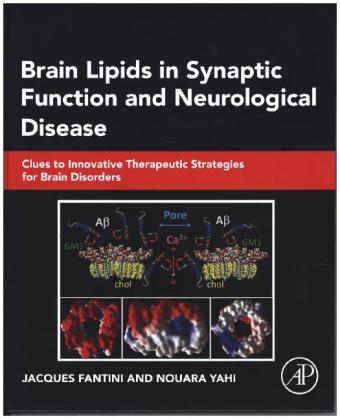
Brain Lipids in Synaptic Function and Neurological Disease
Academic Press Inc (Verlag)
978-0-12-800111-0 (ISBN)
Jacques Fantini was born in France in 1960. He has over 30 years of teaching and research experience in biochemistry and neurochemistry areas. Since 1998, he is professor of biochemistry and honorary member of the ‘Institut Universitaire de France’. He has demonstrated the implication of glycolipids in the attachment and fusion of HIV-1 with the plasma membrane of target cells, and has published several important articles in this field. He is an active member of the research group ‘Molecular Interactions in Model and Biological Membrane Systems’ led by Nouara Yahi. This group is internationally recognized for studies of lipid-lipid and lipid-protein interactions pertaining to virus fusion, amyloid aggregation, oligomerization and pore formation. Together with Nouara Yahi, Jacques Fantini has discovered the universal sphingolipid-binding domain (SBD) in proteins with no sequence homology but sharing common structural features mediating sphingolipid recognition. The SBD is present in a broad range of infectious and amyloid proteins, revealing common mechanisms of pathogenesis in viral and bacterial brain infections, and in neurodegenerative diseases. His current research is focused on the molecular organization of the synapse in physiological and pathological conditions. Jacques Fantini is the author/co-author of 175 articles (PubMed), with 7500 citations and a H-index of 49. He has also published 4 patent applications. Jacques Fantini personal web site: https://jfantini.jimdo.com Nouara Yahi was born in France in 1964. She has accumulated 25 years of fundamental research and teaching experience in virology and molecular biology areas. She has been a pioneer in the analysis of resistance mutations in patients with HIV infections, and has published several important articles in this field. She is currently professor of biochemistry at Aix-Marseille University and leader of the research group ‘Molecular Interactions in Model and Biological Membrane Systems’. This group is internationally recognized for studies of lipid-lipid and lipid-protein interactions pertaining to virus fusion, amyloid aggregation, oligomerization and pore formation. Together with her teammate Jacques Fantini, Nouara Yahi has discovered the universal sphingolipid-binding domain (SBD) in proteins with no sequence homology but sharing common structural features mediating sphingolipid recognition. The SBD is present in a broad range of infectious and amyloid proteins, revealing common mechanisms of pathogenesis in viral and bacterial brain infections, and in neurodegenerative diseases. Nouara Yahi is the author/co-author of 90 articles (PubMed), with 4400 citations and a H-index of 40. She has also published 5 patent applications.
Part I. Brain Lipids1. Chemical basis of lipid biochemistry2. Brain membranes3. Lipid metabolism and oxidation in neurons and glial cells4. Variations of brain lipid content
Part II. Brain Lipids and Synaptic Functions5. A molecular view of the synapse6. Protein-lipid interactions in the brain7. Lipid regulation of receptor function
Part III. Brain Lipids and Neurodegenerative Disease8. Common mechanisms in neurodegenerative diseases9. Creutzfeldt-Jakob’s disease10. Parkinson’s disease11. Alzheimer’s disease
Part IV. Brain Pathogens and Amyloidogenic Proteins: The Lipid Connection12. Viral and bacterial diseases13. A unifying theory14. Therapeutic strategies for neurodegenerative diseases
| Verlagsort | San Diego |
|---|---|
| Sprache | englisch |
| Maße | 191 x 235 mm |
| Gewicht | 950 g |
| Themenwelt | Geisteswissenschaften ► Psychologie ► Biopsychologie / Neurowissenschaften |
| Medizin / Pharmazie ► Medizinische Fachgebiete ► Neurologie | |
| Medizin / Pharmazie ► Medizinische Fachgebiete ► Pharmakologie / Pharmakotherapie | |
| Studium ► 1. Studienabschnitt (Vorklinik) ► Histologie / Embryologie | |
| Studium ► 1. Studienabschnitt (Vorklinik) ► Physiologie | |
| Naturwissenschaften ► Biologie ► Biochemie | |
| Naturwissenschaften ► Biologie ► Genetik / Molekularbiologie | |
| Naturwissenschaften ► Biologie ► Humanbiologie | |
| Naturwissenschaften ► Biologie ► Zellbiologie | |
| ISBN-10 | 0-12-800111-9 / 0128001119 |
| ISBN-13 | 978-0-12-800111-0 / 9780128001110 |
| Zustand | Neuware |
| Haben Sie eine Frage zum Produkt? |
aus dem Bereich


